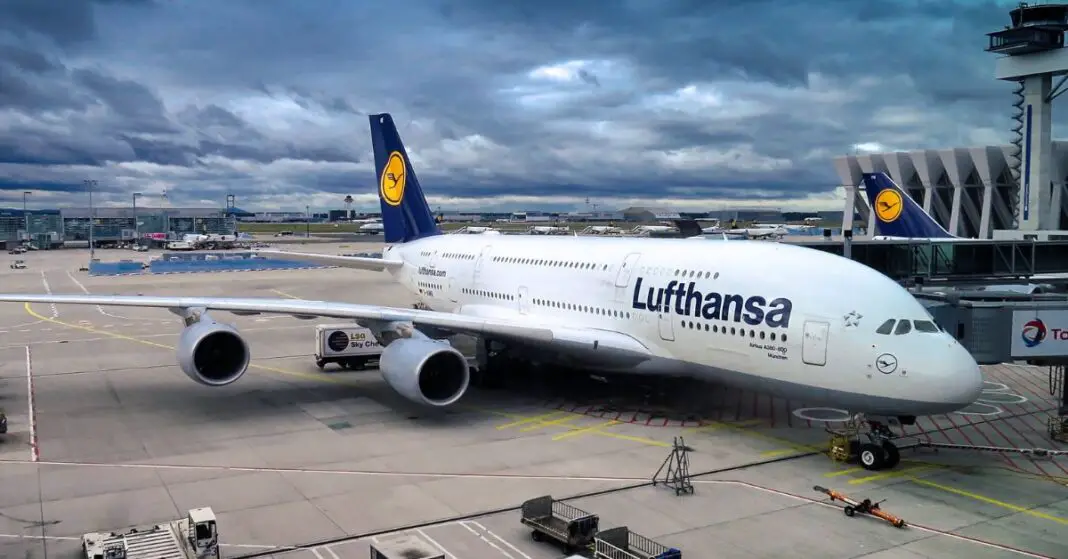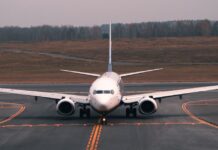Soaring through the sky, the Airbus A380 is not your average plane. It’s changing the way we think about flying. This amazing aircraft is the result of smart ideas and cool technology coming together to create a one-of-a-kind flying experience.
The Airbus A380 is famous for being big, but it’s not just about size. It’s also super high-tech and performs well. This plane is like a work of art because it tackles the usual problems in flying and gives airlines a way to be more environmentally friendly and make money.
Let’s take a closer look at what makes the Airbus A380 such an awesome piece of modern engineering.
Table of Contents
The Innovation behind the Airbus A380 Design
When talk turns to pivotal shifts in aviation design, the Airbus A380 invariably hogs the spotlight. Unveiled in 2005, this astounding airborne colossus symbolizes the zenith of technological innovation, and rightly so. With advancements ranging from wing design to passenger comfort, the A380 has firmly etched its status as an aeronautical marvel and a game-changer in the aviation industry.
Let’s start by addressing the Airbus A380’s wings – the lifelines of any aircraft. Engineers have revolutionized their design, optimizing wingspan and wing sweep to maximum effect. Reaching an impressive 261 feet, the A380’s large wingspan allows it to maintain flight at relatively slower speeds, thereby enhancing fuel efficiency. Moreover, the 33.5-degree wing sweep also mitigates drag, promising longer, smoother journeys.
Equally impressive is the use of advanced materials to construct the A380. Researchers leveraged innovative composite materials for 25% of the structure. This includes GLARE, a unique fusion of glass fiber and aluminum, serving to reduce weight without compromising strength. The use of these materials lightens the aircraft, further improving fuel efficiency.
Massive in stature, the A380 is the world’s largest passenger airliner, boasting two full-length decks that can accommodate over 500 passengers in a typical three-class seating arrangement. However, the real feat is not merely the size, but how space optimization has been redefined. The A380’s design takes passenger experience to unparalleled heights. Noise reduction technologies, advanced LED mood lighting, larger windows; every element is carefully crafted to alleviate the strains of long-haul flights.
The Airbus A380’s design is not just about comfort and fuel efficiency; it also addresses the eco-friendly side of aviation. Thanks largely to Engine Alliance GP7000 and Rolls-Royce Trent 900 engines, the A380 demonstrates a drastic reduction in noise pollution compared to similar aircraft. Also, with lower fuel consumption, the A380 significantly reduces CO2 emissions per passenger.
Yet, what truly marks the A380 as an evolutionary leap is the profound influence it has had on the aviation industry. The ingenious utilization of technology anticipates the future before it happens. Concepts like higher passenger density without compromising comfort, lower per-passenger emissions, and harmonic interplay of materials and design, echo throughout newer aircraft designs, bearing testimony to the A380’s game-changing impact.
The Airbus A380 ceaselessly reminds us of the matchless potential of technology. It embodies the spirit of innovation, propelling the aviation industry into a glorious future where the sky is indeed the limit.
What are some cool facts about the Airbus A380?
Fascinating Facts about the Airbus A380: Size and Capacity:
- Largest passenger aircraft ever built: The A380 can accommodate up to 853 passengers in a single-class configuration, boasting more usable floor space than any other aircraft.
- Double-deck design: This unique layout enables increased seating, amenities, and innovative cabin arrangements.
- Wingspan wider than a football field: The A380’s expansive wingspan ensures efficient lift and fuel economy.
- Power and Technology (Four Rolls-Royce Trent 900 engines): Each engine generates over 70,000 pounds of thrust, making the A380 one of the most powerful aircraft ever constructed.
- Advanced fly-by-wire system: This computer-controlled system enhances safety and handling.
- First commercial airliner with an onboard wireless network: Passengers can stay connected during their flight.
- Environment and Sustainability (Excellent fuel efficiency per passenger): Despite its size, the A380 is surprisingly fuel-efficient, thanks to its advanced design and technologies.
- Lower emissions per passenger than smaller aircraft: The A380’s efficiency contributes to a reduced environmental impact.
- Reduced noise pollution: The A380’s engines are quieter than those of older aircraft.
- Luxury and Amenities (Onboard bars and lounges): Some airlines offer luxurious lounges and bars for passengers to relax and enjoy their flight.
- Duty-free shopping: Select airlines provide duty-free shops on board, allowing passengers to purchase souvenirs and other items.
- Showers and spas: Some airlines even offer shower and spa facilities for first-class passengers.
- Other Interesting Facts:
- More than 43 million people dine on A380 flights every year: That’s a substantial number of meals prepared in the air!
- The A380’s wings are so long that they have to bend upwards to fit into airport gates.
- It takes six years to build a single A380.
- The A380 has flown over 1.7 million hours and completed over 260,000 flights.
The Cutting-edge Technology of Airbus A380
As cutting-edge technology continues to skyrocket, the Airbus A380, the colossal titan of the skies, sets itself apart with unique advanced features, emerging as an exquisite addition to the future of aviation. Although previously discussed components such as its space-age materials, streamlined design, and eco-friendly contribution are unquestionably fascinating, there remain several lesser-known aspects to scrutinize as we peel back the layers of this magnificent aircraft.
One of the A380’s significant tech aspects lies in its advanced cockpit systems. Often dubbed as ‘Glass Cockpit’, this represents a transformational leap in aviation technology. The Airbus A380 is equipped with several large interactive displays providing flight information, navigation systems, and avionic data. This allows for streamlined workflows and significantly increased operational efficiency.
Beyond the visual appeal, the aircraft’s systems are interconnected in a digital web, propelling the interface into the future. The Airbus A380 incorporates a Network Systems Server (NSS), solidifying its stance as a digital titan. The NSS is a server-based software application that enables the crew to manage the maintenance of the airplane, its flight data, and its operation application, serving as a connective tissue to weave the A380’s technological transformations together.
An often-overlooked aspect of its technology is the health and usage monitoring system (HUMS) that Airbus has integrated into the A380. An innovative marvel, HUMS utilizes sophisticated sensors placed around the aircraft to collect and analyze data about the plane’s performance. This data is utilized to predict potential problems, decrease downtime, and significantly increase the aircraft’s lifespan.
The Airbus A380’s avionics display no shortage of wonder, especially when it comes to the design of its hydraulic system. Unlike traditional aircraft that utilize three hydraulic systems, the A380 uses two hydraulic systems and two electrical systems, resulting in a decrease in weight and enhancing fuel efficiency. This advanced concept not only saves costs but contributes to a reduction in noise and vibration in the cabin.
The marvels don’t end at the ground either. The aircraft’s Ground Proximity Warning System (GPWS) is an undeniably impressive piece of tech. This system utilizes technology to measure the aircraft’s height above the ground, even during non-standard flight conditions, sending crucial warnings to the flight deck to avoid potential collisions.
The illumination of these technological aspects imparts a deeper understanding of the Airbus A380’s magnificence. The fine weave of technology in the creation of this ensemble not only inspires admiration for the craftsmanship of the A380 but also heralds the thrilling possibilities the future of aviation holds. Ultimately, machines like the Airbus A380 serve as a paramount testament to the ceaseless march and transformative power of technology.
Airbus A380: Handling and Performance
The aircraft’s superb flight handling is a further testament to its remarkable design and technology.
One of the major role-players in enhancing performance and safe flight operations is the Airbus A380’s advanced Glass Cockpit.
Airbus has pioneered the integration of interactive displays, comprising flight control systems, navigation systems and aircraft system controls—proffering pilots unprecedented oversight and control.
Significantly, the Airbus A380 is known for incorporating enhanced technology.
It utilizes a Network Systems Server (NSS), which plays a pivotal role in the successful operation of the aircraft.
The NSS is the heart of the A380’s data network, acting as the central hub for inflight data processing and exchange.
It streamlines the handling of everything from flight plans and weather updates to systems monitoring and cabin controls.
It’s akin to an onboard supercomputer, which enhances overall operational efficiency.
Taking strides in remote predictive maintenance and suffering fewer in-flight system failures, the Health and Usage Monitoring System (HUMS) is a commendable tech integration in Airbus A380.
The HUMS analyzes data from various sensors throughout the aircraft, pinpointing real-time system performance.
This enables predictive maintenance, mitigating potential issues before they escalate into major problems, thereby optimizing aircraft availability and reducing overhead costs of unplanned system repairs.
Furthermore, the hydraulics system design in the A380 stands out with its unique redundancy and efficiency.
Its design utilizes both 5,000 psi high-pressure green hydraulic circuits and 3,000 psi blue and yellow circuits, the combination of which provides redundancy, maximizes reliability, and minimizes the potential for system failure.
Finally, the A380’s Ground Proximity Warning System (GPWS) is a lifesaver, often working silently in the background.
The GPWS uses radar technology to predict the proximity of the ground even in zero-visibility situations, alerting pilots if the aircraft is flying too close to the ground terrain.
Airbus A380 has honed this technology even further with the integration of the Enhanced Ground Proximity Warning System (EGPWS), providing a more comprehensive detection and alert system.
Examining these unique attributes of the Airbus A380 gives way to the understanding of how it has revolutionized aviation and redefined what it means for aircraft to be truly technologically advanced.
Above and beyond, the Airbus A380 shows us how today’s technology can transform aircraft system management for amplified efficiency and precision, making aviation safer and more reliable than ever before.
Airbus A380 and its Impacts on the Airline’s Economics
The Airbus A380 is more than an engineering marvel; It is a literal game-changer in the aviation industry. It is renowned for its mammoth size, yet its most significant influence lies much deeper than its formidable appearance – it has fundamentally altered the economics of airlines.
One such realm is operational efficiency. The A380’s sophisticated systems, such as the Advanced Glass Cockpit and the Network Systems Server (NSS), jazz up the cockpit with digital technology and replace traditional manual inputs with a philosophy of system automation. They boost efficiency by integrating multiple functions into a single server, making operational procedures smoother and less complex. This directly translates to reduced workloads on crew members, less training time, and lower operational costs for airlines.
Furthermore, the Health and Usage Monitoring System (HUMS) and groundbreaking Hydraulics system design bolster regular maintenance and decrease the likelihood of unexpected breakdowns. HUMS uses real-time data monitoring to signal component wear and tear long before it becomes a substantial issue, reducing both maintenance time and costs.
The revamped Hydraulics system design, on the other hand, cuts the risk of system failure, subsequently reducing airborne delays, grounding instances, and long-term repair costs. These innovations decrease aircraft downtime and increase reliability, both of which are critical to economic performance in the sector.
The A380’s innovative take on safety, specifically through the Ground Proximity Warning System (GPWS) and its enhanced version (EGPWS), has also brought economic advantages. Reducing the potential for Controlled Flight Into Terrain (CFIT) significantly, these systems substantially decrease the odds of costly incidents and the ensuing damage to airlines’ reputations, which could be even more economically devastating.
Aside from direct cost reductions, the Airbus A380 has influenced airline economics by fundamentally altering air traffic patterns, with its size and efficiency allowing for the decentralization of air traffic. Airlines now can operate fewer flights with more passengers, maximizing their output out of heavily congested airports. This has directly impacted their scheduling ability, optimizing their revenue capacity and strengthening their foothold within the competitive airspace.
Finally, the Airbus A380’s technological advances have spurred the continual evolution and competitiveness in the aviation industry. The bar has been set high – and to keep up, other manufacturers have been nudged into accelerating their technological advances, a competition which generally results in more efficiency and lower operational costs.
The Airbus A380 has been a pivotal force in moving the aviation industry forward, its technological insights having widespread implications, reshaping industry practices, and redefining economic benchmarks. Despite its mammoth size, it became a catalyst for more significant innovations, proving yet again that in our technology-infused world, the sky truly isn’t the limit. It’s just the beginning.
With the ability to offer airlines unique competitive advantages, the Airbus A380 makes a major impact on airlines’ economics. Not only is it a testimony to technological sparkle, but also a beacon of economic efficiency. From the immense savings on fuel costs to its superior passenger-carrying capability, it redefines cost-efficiency in air travel, making it a worthwhile investment for airlines.
The A380, with its mesmerizing blend of technology and performance, doesn’t just offer a luxurious travel experience for passengers but also serves as an embodiment of optimum efficiency and financial prudence for airlines. Thus, the Airbus A380 stands as more than just an aircraft; it’s a symbol of sophistication, technological excellence, and economic intelligence.
Why is the A380 so special?
The A380, recognized as the world’s largest passenger aircraft, features a roomy double-deck design and occupies a unique position in aviation due to its innovative technology, environmental performance, and association with luxury. Although its production has ceased, the A380’s legacy endures through its influence on airport infrastructure and the design of future aircraft, marking it as an extraordinary plane.
What is the advantage of Airbus A380?
The Airbus A380 distinguishes itself with its remarkable passenger capacity, fuel efficiency, expansive and well-appointed cabin, capability to alleviate airport congestion, advanced safety features, and positive impact on airline’s brand image. These benefits position it as a formidable option for airlines serving high-demand routes and operating in congested airports.
What is the disadvantage of Airbus A380?
Despite its impressive passenger capacity and efficiency, the A380 faced challenges such as high operating costs, limited airport compatibility, a niche market appeal, complex maintenance requirements, and competition from smaller, more versatile aircraft. These factors ultimately contributed to its discontinuation, with production coming to an end in 2021.
Why do airlines not like A380?
The decline in the popularity of the A380 among airlines can be attributed to several factors, including high operating costs, limited network flexibility, niche market appeal, complex maintenance, and competition from newer, more efficient aircraft.
The cessation of A380 production in 2021, coupled with increasing fuel costs and environmental considerations, has further diminished its appeal. Airlines, prioritizing cost-cutting and efficiency, are turning to smaller, more flexible aircraft, leaving the future of the A380 in the aviation industry uncertain.






